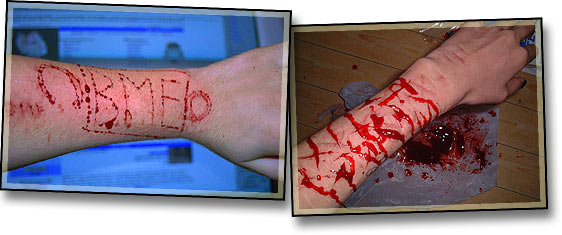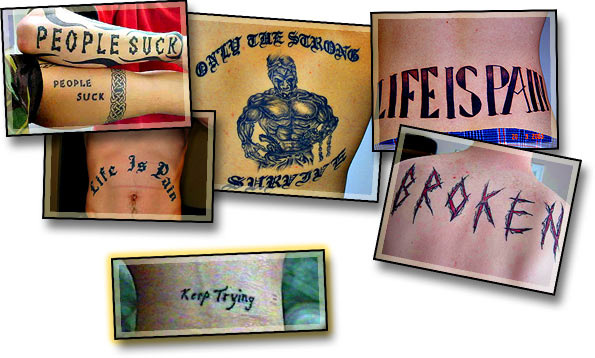
by Shannon Larratt
Nature shows that with the growth of intelligence comes increased capacity for pain, and it is only with the highest degree of intelligence that suffering reaches its supreme point.
I'd like to introduce two guest columns on the same subject — self-injurers, people who cut themselves to get through life — and then follow with a few thoughts of my own. You may want to read the guest columns first:
But that can't be true, can it?
 Now let's take a cold look at body piercing and tattooing. It is a painful act done without anesthesia or pain control, often in unregulated and unsanitary situations that put the wearer at needless risk, to say nothing of the long term potentially stigmatizing and life-destroying effects. If we are to judge ourselves by the same standards, that is... And what of suspension, pulling, and play piercing? Or even SM sex play where people "get off" on pain? Clearly on an objective level these are sick people hurting themselves for no good reason. But we know that's not true because we've been there. After all, we hold up as a hero the woman who reclaims her body with a genital piercing after being raped. We don't even think to point out that maybe she's now a headcase that's carrying on the abuse by mutilating her genitals — because we know that's not true. We're thrilled to read the story of the young down-on-his-luck man who's feeling "reborn" after his first suspension — we would never say "well, if you thought he was messed up before, look at the sick stuff he's doing now, hanging from hooks!" Maybe you're telling yourself that you and the folks I've just mentioned in the previous paragraph are "better" than self-injurers because you're wearing marks of "something good" (which you probably can't put into words, let alone prove to a psychiatrist). Ignoring the fact that to some self-injurers the cuts represent survival ("something good"), and ignoring the fact that many "normal" people see all modifications as marks of "something bad", plenty of modifications are very specific markers of problems — after all, "Born to Lose" and "Life is Pain" are two of the most persistent and popular classic tattoo designs. ...and you're telling me that saying "I'm a survivor" is somehow worse than "I'm a loser"?
 It should come as no surprise that many people see pain as good and life-affirming. "No pain, no gain" is the motto of a vast number of self-improvement schemes — we understand that facing and surviving pain is a part of bettering oneself and of facing life's challenges. Even "love hurts". Extreme athletes and thrill seekers describe feeling more and more alive the closer they get to death. We make heros of people who've lived through painful accidents, and reward those who endure painful trials of fire. Pain may hurt, but all of our legends and myths tell us that it's the path to divinity. Now, don't get me wrong. I'm not saying that we should encourage people to see injuring themselves as a solution. If someone is hacking up their arm to get through life, then there are very likely problems in their life that need fixing — but don't ever assume that the injury is the problem. At best it's a symptom, and no one was ever helped by trying to suppress their symptoms. And guess what — sometimes tattoos and piercings are also symptoms of a problem. So are lots of things. If self-injury helps a person improve their lives, then it's a good thing in my books, and every bit as valid as an injury that you happened to pay someone else to do to you. Personally, I even think it can look good. So try and treat them with the same respect and caring as you'd expect from some mundane about to approach you about your facial piercings.
Be healthy,
Shannon Larratt is the editor and publisher of BMEzine.com, and writes the regular column The Publisher's Ring. He lives in rural Canada with his wife and daughter, and can be found on IAM as iam:glider. Requests to republish must be confirmed in writing. For bibliographical purposes this article was first published online October 30th, 2003 by BMEZINE.COM in Tweed, Ontario, Canada. |

